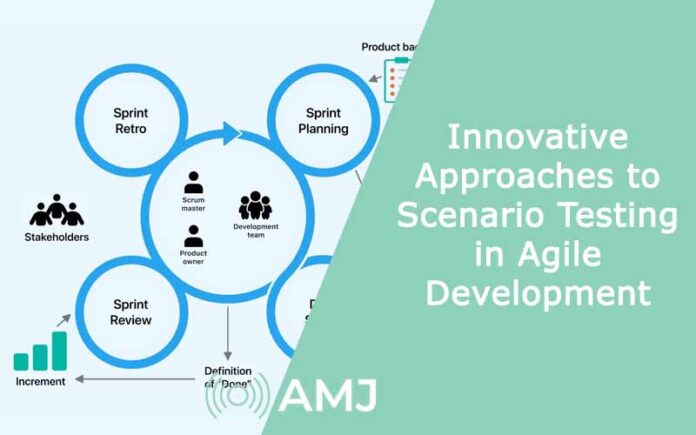Agile development methodologies like Scrum, Kanban, and Lean emphasize flexibility, adaptation, and iterative delivery to satisfy customer needs. In the Agile paradigm, software is developed incrementally in short iterations called sprints, typically 2-4 weeks. Requirements and Scenario testing evolve through collaboration between self-organizing cross-functional teams. Continuous customer feedback through demonstrable and testable products in each sprint is valued over comprehensive documentation.
With new features delivered frequently, Agile teams must test every possible flow and scenario to guarantee high quality. However, testing large and complex applications across different browsers and devices with traditional methods can be challenging and time-consuming.
This blog aims to highlight innovative scenario-testing approaches that address such difficulties. It will discuss how QA is key in Agile and explore common scenario testing practices along with their limitations.
Contents
- 1 Understanding Scenario Testing
- 2 Traditional Scenario Testing Methods
- 3 Traditional Challenges with Agile Scenario Testing
- 4 BDD-driven Scenario Testing
- 5 Model-based Scenario Testing
- 6 Cloud-based Scenario Testing Services
- 7 What is LambdaTest?
- 8 Innovative Approaches to Scenario Testing with LambdaTest
- 9 Automation in Scenario Testing with LambdaTest
- 10 Conclusion
Understanding Scenario Testing
Scenario testing involves determining how a system responds when certain conditions or situations occur. It aims to validate business processes end-to-end by simulating real-world scenarios and user behaviors. In essence, scenario tests exercise multiple functions and features collectively to confirm they behave as intended when integrated under various conditions. This verifies overall system functionality and catches errors stemming from component interactions.
Scenario testing differs from unit or integration testing, which focuses on isolated units or interfaced modules, respectively. It provides a broader perspective on functionality by mimicking complex user workflows from a black-box viewpoint. Scenarios also consider edge cases, invalid conditions, and alternative paths to identify faults masked by localized testing. This makes scenario testing critical for agile, where predicting all permutations is challenging given short cycles.
Traditional Scenario Testing Methods
Common scenario testing practices include exploratory testing, use case testing, user journeys, and session-based testing. These methods often involve manually executing scenarios on limited devices and browsers. Testers explore error paths and validate expected outcomes for each scenario.
While traditional techniques help cover core scenarios, they have several limitations, like inflexible infrastructure, slow feedback cycles, lack of automation, and scalability issues for complex applications. Manually testing large scenarios across different browsers is time-consuming and error-prone. Cross-browser inconsistencies are challenging to identify in a few environments.
Traditional Challenges with Agile Scenario Testing
Adopting agile brought many benefits to development but also challenges to QA processes like scenario testing. Some limitations of conventional testing approaches for agile include:
- Sequential Testing: Traditional waterfall methods involve sequential phases, which hamper iterative workflows. Scenarios need flexible, iterative execution.
- Brittle Automation: Hardcoded scenarios break easily due to frequent code changes. Updating many interlinked scripts slows releases.
- Slow Feedback Loops: Long test cycles fail to support rapid iterations. Test failures late in a cycle waste development effort.
- Poor Test Coverage: Focus on new code risks missing regressions. Tracking all changes exhaustively is impractical.
- Inflexible Resources: Dedicated test environments take time to set up and are costly to change frequently.
- Slow Tooling: Heavyweight test management tools struggle to keep up with the pace of agile development.
Addressing these challenges requires rethinking scenario testing models. New strategies are needed to make scenario automation adaptable, sustainable, and fast in agile environments.
BDD-driven Scenario Testing
A behavior-driven development (BDD) approach transforms scenario testing for agile. BDD focuses testing on validating business goals and requirements by automating “acceptance criteria” stories collaboratively defined by stakeholders.
Key principles of BDD-driven scenario testing include:
- Executable Specifications: Scenarios are written in a business-readable format like Gherkin and serve as both documentation and automated tests.
- Role-based Automation: Automation focuses on the customer/user perspective rather than technical implementation details.
- Feedback Loops: Automated scenarios run with each build to catch failures immediately and keep tests aligned with code changes.
- Living Documentation: Scenarios evolve together with requirements in source control for transparent traceability.
- Collaboration: Stakeholders from different roles define and discuss scenarios together through all phases.
This mitigates many challenges of traditional scenario testing. Automated scenarios are resilient to code changes, support rapid iterations, facilitate collaboration, and provide customer-centric validation of requirements. BDD is highly effective for agile.
Model-based Scenario Testing
Another approach gaining popularity is model-based scenario testing, which utilizes system or domain models to derive and validate test scenarios. Models precisely define components, behaviors, and relationships, which helps to:
- Generate diverse scenarios programmatically covering different logical paths and corner cases not considered manually. This improves test coverage.
- Maintain scenario consistency when models or code evolve since tests are derived directly from models.
- Check intended vs actual system behavior by simulating models and evaluating outcomes against implementation. Early defects are caught.
- Scale testing to handle large, complex systems. Models partition domains for more manageable scenario development and execution.
- Trace requirements through models to tests for comprehensive validation and impact analysis of changes.
Tools like Spec Explorer, AutoScreenshot, and model-based testing integrations assist with automating these capabilities for agile development pipelines. Using models alongside code empowers teams for exhaustive yet flexible scenario testing.
Cloud-based Scenario Testing Services
Cloud-based testing services greatly enhance agile scenario testing by addressing its critical pain points of scalability, flexibility, and speed of feedback. A platform like LambdaTest enables on-demand provisioning of varied environments to run parallel test execution.
This helps agile teams to:
- Scale infrastructure resources up or down elastically based on testing needs, avoiding wasted capacity when demand fluctuates regularly.
- Distribute tests across a grid of automated browsers/emulators/devices in the cloud for test data decentralization. Tests are completed much faster.
- Gain visibility into real-user experiences across myriad OS/browser/device configurations from a single portal. Corner cases don’t slip through the cracks.
- Eliminate setup and maintenance overheads of physical/VM-based labs. Resources are available on-tap without lag.
- Benefit from managed services’ capabilities like AI-based intelligent debugging, visual regression as a service, and video recordings for easier defect revelation.
- Integrate scenario testing seamlessly into CI/CD pipelines through APIs and plugins for SCM and testing tools. Feedback is extremely rapid.
Such platforms help agile teams adopt powerful scenario testing methods readily without upfront investment or expertise required to run local infrastructure. This removes bottlenecks to efficient testing.
What is LambdaTest?
LambdaTest is a next-generation, cloud-based cross-browser testing platform that helps engineering and QA teams test web applications across 3,000+ browsers, check responsiveness across different screen sizes, and test on real devices. Engineering teams can debug issues 10x faster with tools like live session, video, and browser console logs for every test run.
With LambdaTest, teams can test web applications and desktop applications on all major operating systems, including Windows, Mac, Linux, iOS, and Android. Users also get access to the fastest resolutions and Geolocation testing to ensure the quality and performance of their web applications.
Key Features of LambdaTest:
- Real Browser Testing: Run tests on a wide range of browsers like IE 11, Edge, Firefox, Chrome, Safari, Opera, and even browsers for iOS and Android to ensure compatibility.
- Automation Testing: Integrate with popular CI/CD tools like Jenkins, CircleCI, and GitHub Actions for seamless test automation. Users can configure LambdaTest as a Docker container as well.
- Smart Testing: AI-powered smart testing capabilities help users run smarter tests by identifying frequently failing test scenarios, reducing redundant test runs, and recommending optimization techniques to achieve faster execution times.
- Parallel Testing: Execute multiple tests simultaneously on the cloud infrastructure and reduce testing time significantly. Run tests across operating systems, browsers, and devices in parallel.
- Debugging Tools: Features like live sessions allow debugging tests on the go. Capturing browser screenshots, console logs, and video recordings helps users debug errors instantly without switching environments.
- Geolocation Testing: Test applications from different cities around the world to ensure features like currency conversion, content localization, etc., work seamlessly for global users.
- Collaborative Features: Real-time communication allows the sharing of test results and collaboration with team members. Integrations with bug-tracking tools facilitate issue logging.
Innovative Approaches to Scenario Testing with LambdaTest
Below are a few approaches when using Lambdatest to help enhance the scenario testing.
Behavior-Driven Development (BDD)
BDD brings business stakeholders, developers, and testers together through scenarios and conversations. Using tools like Cucumber, scenarios are automated in a format non-technical users understand.
LambdaTest integrates with popular BDD libraries and frameworks like Cucumber and SpecFlow, enabling teams to automate scenarios in their preferred language like Ruby, Java, C#, etc. Configuring LambdaTest’s parallel simulation allows running all scenarios simultaneously on different browser configurations with a single click.
Built-in report generation and collaboration features provide results visibility. Teams catch defects early while fostering collaboration through executable specifications checked on real browsers. BDD mitigates risks by testing business logic first before coding to deliver maximum value.
Test-Driven Development (TDD)
In TDD, developers write automated tests before the code. Scenarios validate incremental changes. LambdaTest streamlines the implementation of TDD approaches by removing infrastructure complexities.
Developers can write fast, isolated unit tests targeting specific browser behaviors on real browsers. Parallel testing runs tests across platforms with a single command, catching cross-environment issues.
Integration with IDEs and build tools helps run tests on every code change automatically. Debugging tools analyze failures on corresponding browsers without switching contexts. Teams achieve more coverage through continuous integration and catch slip-through issues earlier in the development cycle.
Exploratory Testing
Exploratory testing aims to surface hidden issues by emulating user behavior with no scripted scenarios. Using LambdaTest, quality engineers can simulate real user sessions across multiple browsers.
Smart virtual machines load web pages instantaneously to explore flows like an actual user. Simultaneously, testing on different machines allows for comparing behaviors. Live sessions provide live snapshots, video recordings, and logs to analyze issues on the spot without disruption.
Automation in Scenario Testing with LambdaTest
Popular testing frameworks supported by LambdaTest include Selenium, Cypress, Playwright, and Appium helping users automate scenarios for web and mobile applications. Pre-configured CI/CD environments alongside Docker container support enable seamless integration.
Automating scenarios with LambdaTest helps simulate real user workflows at scale across endless configurations. Real-time test data syncs browser states for parallel testing. Debugging errors during execution becomes easier using Video/screenshots on failing browsers.
LambdaTest’s responsive, scalable cloud grid distributes tests evenly, mitigating bottlenecks due to infrastructure limitations. Automating scenarios thus guarantees consistent quality through fast iterative cycles. Parallel capabilities improve productivity by trimming testing cycle times.
Continuous Integration and Continuous Deployment (CI/CD)
LambdaTest extends CI/CD pipelines by adding a seamless deployment-testing feedback loop, enabling automated quality checks through virtualized testing clusters. Integrations with CI tools trigger tests on every code push.
Periodic scenario refactoring aligns tests with changing code. Dashboards provide visibility to track coverage and history. Overall, full test automation in CI/CD reduces risks and accelerates delivery through scenario quality validation.
Conclusion
As agile transforms development, innovative testing approaches are indispensable for keeping pace with rapid iterations while ensuring quality expectations are fulfilled. By embracing principles of BDD, models, and cloud-based parallelization, organizations can empower agile teams with scalable, consistent, and resilient scenario testing practices. With strategic leveraging of new methods, QA need no longer constrain agility but rather complement it.












![Index of Money Heist [Season 1, 2, 3 & 4 – All Episodes, Cast and Plot] Index of Money Heist](https://www.asiamediajournal.com/wp-content/uploads/2021/05/Index-of-Money-Heist-3-100x70.jpg)